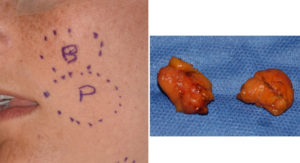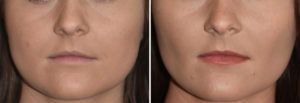Background: Faces are well known to come in a wide variety of shapes. One of the well known facial shapes is the square one. The square facial shape is created mainly by the influence of the facial bones. One has to have strong cheek and jawline bones to make such a facial shape….at least in younger and weight appropriate patients. The cheeks and their zygomatic arch extensions must match the width of a strong jawline and jaw angles to create a facial ‘box’ appearance

The aesthetics of the square facial shape can be marred if it has an intervening convexity between the cheeks and the jawline. Such ‘fullness’ can make the square face look less attractive than if there was a convexity present.
Case Study: This 23 year-old female requested fat removal from her face to give a more contoured look. She had a square facial shape with a straight line profile between her cheeks and jawline. She was very weight appropriate for her height.


Highlights:
1) Thinning of the more square facial shape can be done by decreasing soft tissue volume between the convex skeletal shapes.
2) Creating a facial concavity can be done by buccal lipectomies and perioral mound liposuction.
3) Such facial thinning effects creates a subtle but noticeable facial shape improvement.
Dr. Barry Eppley
Indianapolis, Indiana




